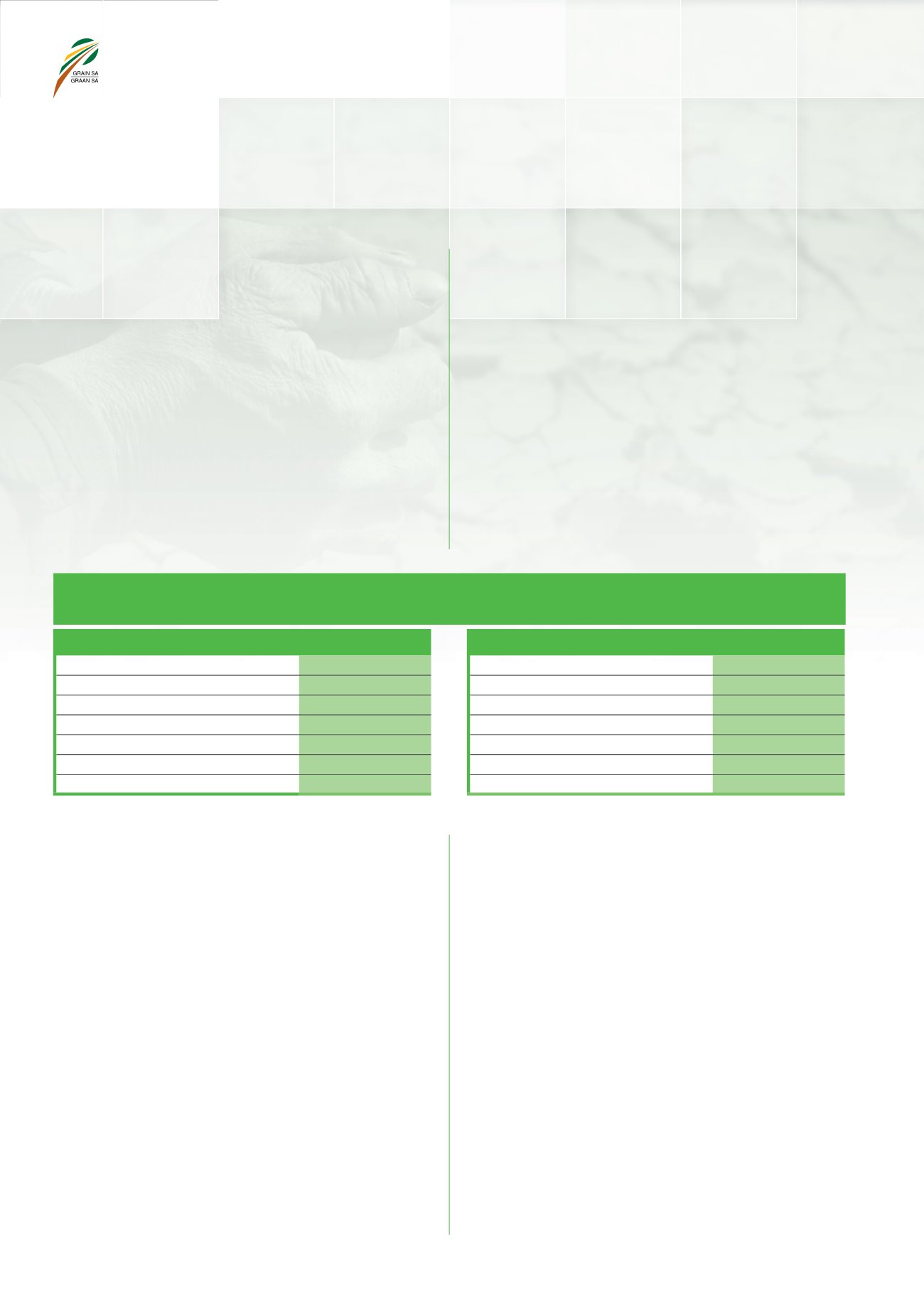

12
GRAIN ECONOMY AND MEMBER MARKETING
Production conditions
T
he 2018/2019 season was once again challenging for the
summer and winter grain regions. In the summer rainfall region
the rain occurred late. Everyone held their breath to see whether
the frost would stay away and what the yields would be. According to
the ninth estimate of the National Crop Estimates Committee (CEC),
South Africa produced the following crops in the summer grain
region (
Table 1
):
GRAANEKONOMIE EN LEDEBEMARKING
Produksietoestande
D
ie 2018/2019-seisoen was weer eens uitdagend vir beide die
somer- en wintergraangebiede. In die somerreënvalstreek was
dit ’n jaar waarin reën laat ontvang is. Almal het asem opgehou
om te sien of die ryp gaan wegbly en wat die opbrengste gaan wees.
Volgens die Nasionale Oesskattingskomitee (NOK) se negende skatting
het Suid-Afrika die volgende gewasse in die somergraangebied
geproduseer (
Tabel 1
):
Grain Economy and Marketing
Graanekonomie en Bemarking
Members and image
of Grain SA supported
effectively
Lede en Graan SA
se beeld effektief
ondersteun
Grondboonproduksie was veral uitdagend met reën wat nie betyds
geval het nie en gevolglik is slegs 19 455 ton grondbone geproduseer.
Sojaboonproduksie het ’n stram jaar beleef met ondergemiddelde
opbrengste. Dit, tesame met goeie verbruiksyfers, het weer die vraag en
aanbod van sojabone in balans gebring gegewe ’n hoë oordragvoorraad
vanaf die vorige seisoen. Dit bly ’n wonderwerk en ’n groot seën om in
so ’n uitdagende jaar steeds dié tonne te kon produseer.
Die gradering van mielies was wel in sekere streke problematies en
produsente het as gevolg daarvan inkomste verloor. ’n Positiewe
beweging was die nuwe rekordverbruiksyfers wat behaal is vir mielies
(10,7 miljoen ton in 2018/2019 verwerk) en sojabone (1,3 miljoen ton
in 2018/2019 verwerk). Graan SA is vol vertroue dat dié tendens in die
medium termyn sal voortduur.
Inligting
Graan SA het ruim tyd belê in die bevordering van die bedryf deur:
Insetkoste te monitor gegewe internasionale bewegings en neigings.
Invoertariewe op insette te verwyder.
Internasionale en plaaslike navorsingkoördinering vir die bevordering
van produksie.
Versameling en verspreiding van markinligting om beter bemarkings-
besluite te neem wat insluit ad hoc-verslae, daaglikse markverslae,
video’s in samewerking met die Buro vir Voedsel- en Landbou-
beleid (BFAP), asook aanbiedings by boeredae, konsultasie met
TABLE 1 – Crops produced in the summer grain region in 2018/2019.
TABEL 1 – Gewasse geproduseer in die somergraangebied in 2018/2019.
CROP
Ton
White maize
5 538 240
Yellow maize
5 647 810
Sunflower seed
680 940
Soybeans
1 170 345
Groundnuts
19 455
Sorghum
134 525
Total
13 257 670
GEWAS
Ton
Witmielies
5 538 240
Geelmielies
5 647 810
Sonneblomsaad
680 940
Sojabone
1 170 345
Grondbone
19 455
Sorghum
134 525
Totaal
13 257 670
Bron: NOK
Source: CEC
Groundnut production was particularly challenging, with rain not occurring
in time and only 19 455 tons of groundnuts therefore being produced.
Soybean production experienced a taxing year with below-average
yields. This, together with good consumption figures, brought the supply
of and demand for soybeans into balance again, given a high carry-over
stock from the previous year. It remains a miracle and a great blessing to
have been able to produce these tonnages in such a challenging year.
The grading of maize was a problem in certain regions, and producers
lost income as a result. A positive trend was the new record consumption
figures achieved for maize (10,7 million tons processed in 2018/2019)
and soybeans (1,3 million tons processed in 2018/2019). Grain SA is
confident that this trend will continue in the medium term.
Information
Grain SA has invested considerable time in promoting the industry by:
Monitoring input costs, given international movements and trends.
Removing import tariffs on inputs.
Co-ordinating international and local research to promote production.
Gathering and disseminating market information, including ad
hoc reports, daily market reports, videos in collaboration with the
Bureau for Food and Agricultural Policy (BFAP), and presentations
at farmer days, consultations with the government regarding
the regulatory environment, in order to allow better marketing


















